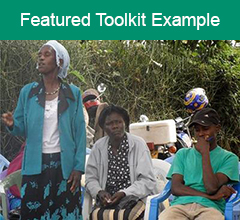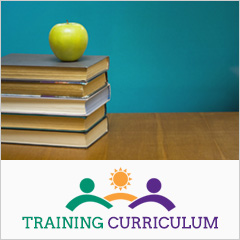This toolkit helps in developing a plan for enhancing leadership and its core tasks.
- Become engaged as a community leader.
- Develop and communicate a personal vision.
- Indicate how will you listen to people.
- How will you take responsibility for your community?
- Set goals.
- How will you serve individuals in the group?
- How will you serve the group as a whole?
- Propose specific changes in how you will lead others.
- How you will get the work done?
- How will you recruit and prepare others to become leaders?
Related resources:
Learning How to Be a Community Leader
Developing and Communicating a Vision
Understanding People's Needs
Discovering and Creating Possibilities
Building and Sustaining Relationships
Conducting Effective Meetings
Influencing People
Building and Sustaining Commitment
Developing a Plan for Building Leadership
Developing a Community Leadership Corps: A Model for Service-Learning
- Assess your own competence in core tasks of leadership, and plan for improvement. Consider your ability for each task and how you will enhance your own competency in each of the nine core tasks:
- Envisioning goals
- Affirming values
- Motivating
- Managing
- Achieving workable unity
- Explaining
- Serving as a symbol
- Representing the group
- Renewing
Related resources:
Learning How to Be a Community Leader
Making Decisions
- Assess your group's competence in core tasks of leadership and plan for improvement. Consider abilities of the group's leaders and members for each of the eight core tasks below and note how your group's competence will be enhanced in:
- Envisioning goals
- Affirming values
- Motivating
- Managing
- Achieving workable unity
- Explaining
- Serving as a symbol
- Representing the group
Related resources:
Developing a Plan for Building Leadership
Building Teams: Broadening the Base for Leadership
- Envision the leadership of the group.
- Identify the core tasks of leadership needed for this work (e.g., your project)
- Indicate how many leaders are needed (or wanted) on the team
- Specify what skills are needed for this work.
- Indicate who needs to be included to reflect the community and its interests.
- Describe how the leadership team will support one another and what additional supports are available to them.
- Indicate what commitment there is to working together in common purpose.
Related resources:
Developing a Plan for Building Leadership
Developing a Community Leadership Corps: A Model for Service-Learning
- Set leadership development goals for the group and its members.
- Indicate the strengths of the group, noting what should be enhanced.
- Indicate gaps between the current situation and the ideal team, and how these will be addressed through recruitment or development.
- Based on differences between the leadership team and those served, indicate in what ways, if any, that diversity of the team should be enhanced.
- Indicate specific goals for leadership development and priorities to be addressed.
Related resources:
Developing a Plan for Building Leadership
Building Teams: Broadening the Base for Leadership
Providing Supervision for Staff and Volunteers
- Select methods for developing leadership. Indicate how you (your group) will:
- Teach as you lead through modeling.
- Arrange workshops and training.
- Provide access to more experienced mentors or coaches.
- Form learning networks and leadership support groups.
- Use retreats to reflect on the work and to restore members for continuing the work.
Related resources:
Developing a Plan for Building Leadership
Learning from and Contributing to Constituents
Designing a Training Session
Conducting a Workshop
Providing Support for Staff and Volunteers
Organizing a Retreat
- Recruit new people to lead. Indicate how you (your group) will:
- Attract new members to serve as leaders of the group.
- Determine together how they will be involved.
- Enhance diversity or abilities, experience, relationships, and cultural competence in the team.
- Prepare new generations of leadership for this work.
Related resources:
Developing a Plan for Increasing Participation in Community Action
Developing a Plan for Building Leadership
Promoting Participation Among Diverse Groups
Encouraging Leadership Development Across the Lifespan
- Enhance collaboration within and across groups. Consider how you will:
- Serve as a catalyst of change.
- Lead the process, not the people.
- Know the leadership context.
- Facilitate the work among partners
- Motivate.
- Be flexible and persistent.
- Distribute credit.
Related resources:
Coalition Building I: Starting a Coalition
Promoting Participation Among Diverse Groups
Collaborative Leadership
- Promote leadership as service. Consider how you will encourage group members to:
- Act as one among equals.
- Use power legitimately.
- Do the necessary work.
- Listen to and care for those served.
- Start where people are.
- Challenge others.
- Adapt to fit the situation.
- Inspire others to answer the call of service.
Related resources:
Servant Leadership: Accepting and Maintaining the Call of Service
Developing a Community Leadership Corps: A Model for Service-Learning
- Promote adaptation to new situations. Consider how you will:
- Identify the adaptive challenge.
- Keep the level of stress within a tolerable range.
- Focus attention on ripening issues.
- Give the work back to the people.
- Protect the voices of leadership without authority.
Related resources:
Adapting Community Interventions for Different Cultures and Communities
Developing Facilitation Skills
Participatory Approaches to Planning Community Interventions
- Indicate how you will build a great group with strong leadership. Communicate how you will:
- Find and attract talented people.
- Create a situation in which people can apply their talents.
- Get great projects in which people can work together.
- Assure that the right people are in the right jobs.
- Protect members from distractions and demands of the broader environment.
- Build bridges to those people and resources that can help.
- Prompt reflection on the meaning of the work.
- Maintain a climate of optimism in the group.
Related resources:
Developing a Plan for Building Leadership
Building Teams: Broadening the Base for Leadership







